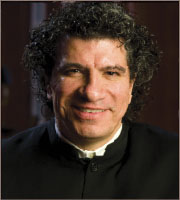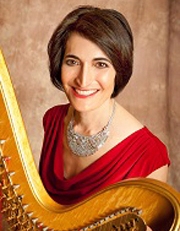
Music Hall Welcomes Bounty of Works
Cincinnati’s Music Hall has been criticized for being too big. And with 3,400 seats, it is hard to fill, but not with music.
Home of the Cincinnati Symphony Orchestra and with excellent acoustics, it welcomes a wide range of repertoire. Heard at Friday morning’s CSO concert at Music Hall were examples large and small.
They included the intimate Theme and Variations for Harp and String Orchestra by Joaquín Turina, featuring CSO principal harpist Gillian Benet, Ottorino Respighi’s huge, splashy “Feste Romane” (“Roman Festivals”), a Technicolor tone poem calling for large orchestra, Beethoven’s classic, Mozartean Piano Concerto No. 2 in B-flat Major with guest artist Ingrid Fliter and to open the concert, Rossini’s genial, mid-sized Overture to “The Barber of Seville.”
On the podium was guest conductor Giancarlo Guerrero, music
director of the Nashville Symphony Orchestra.

Argentine-born Fliter offered a fine performance of the
Beethoven Concerto (interestingly, she used the music and turned the pages
herself). Crafting a perky sound on her first entrance, she performed the
opening Allegro con brio with great precision. The Adagio was beautifully shaped, Fliter providing filigree
treatment of the repeat of the principal theme. The finale, delightfully
syncopated with rhythmic displacement of the rondo theme, brought the Concerto
to a witty conclusion, again with Fliter moving like quicksilver over the keys.

Turina’s Theme and Variations for Harp and String Orchestra was dedicated to former CSO creative director Rafael Frühbeck de Burgos, as was the concert as a whole (Frühbeck died in June, 2014). Dating from 1945, the 12-minute piece was originally set for harp and piano. Frühbeck, who led its CSO premiere in 1989 and was to have conducted this concert, prepared the orchestral version in the 1980s.
It is an impressionistic-sounding, Spanish-colored work,
beginning with muted string accompaniment. Working closely with Guerrero and
the CSO strings, Sella gave it a brilliant reading, full of clarity and sparkle.
Providing lovely solo work of their own were acting associate concertmaster
Kathryn Woolley and principal cellist Ilya Finkelshteyn.

Respighi’s “Feste Romane,” third in his trilogy of works about the city of Rome (the others being “The Fountains of Rome” and “The Pines of Rome”) was led with great skill and zest by Guerrero. The opening movement, “Circus Games,” depicts events which took place in the Circus Maximus, such as gladiatorial contests and the sacrificing of Christians to wild beasts. Bright, offstage trumpets, sounded from the balcony, set the tone, which only grew in furor and intensity.
“The Jubilee,” an every-fiftieth-year event involving a pilgrimage to Rome and the remission of sins, grew from a dark beginning to a joy-filled effusion. There was considerable melodic interest in “Harvest Festivals in October,” including a serenade for mandolin, performed by Paul Patterson, while all hell broke loose in “Epiphany,” a depiction of the night before Epiphany in Rome’s Piazza Navona. Beginning with shrill clarinets, it incorporated all manner of dance and folk rhythms (saltarello, etc.) and the army of percussionists arrayed behind the orchestra were heard in full force as the work moved to its raucous conclusion.
Repeat is 8 p.m. tonight at Music Hall. Tickets begin at $12, available by calling (513) 381-3300, or visit www.cincinnatisymphony.org